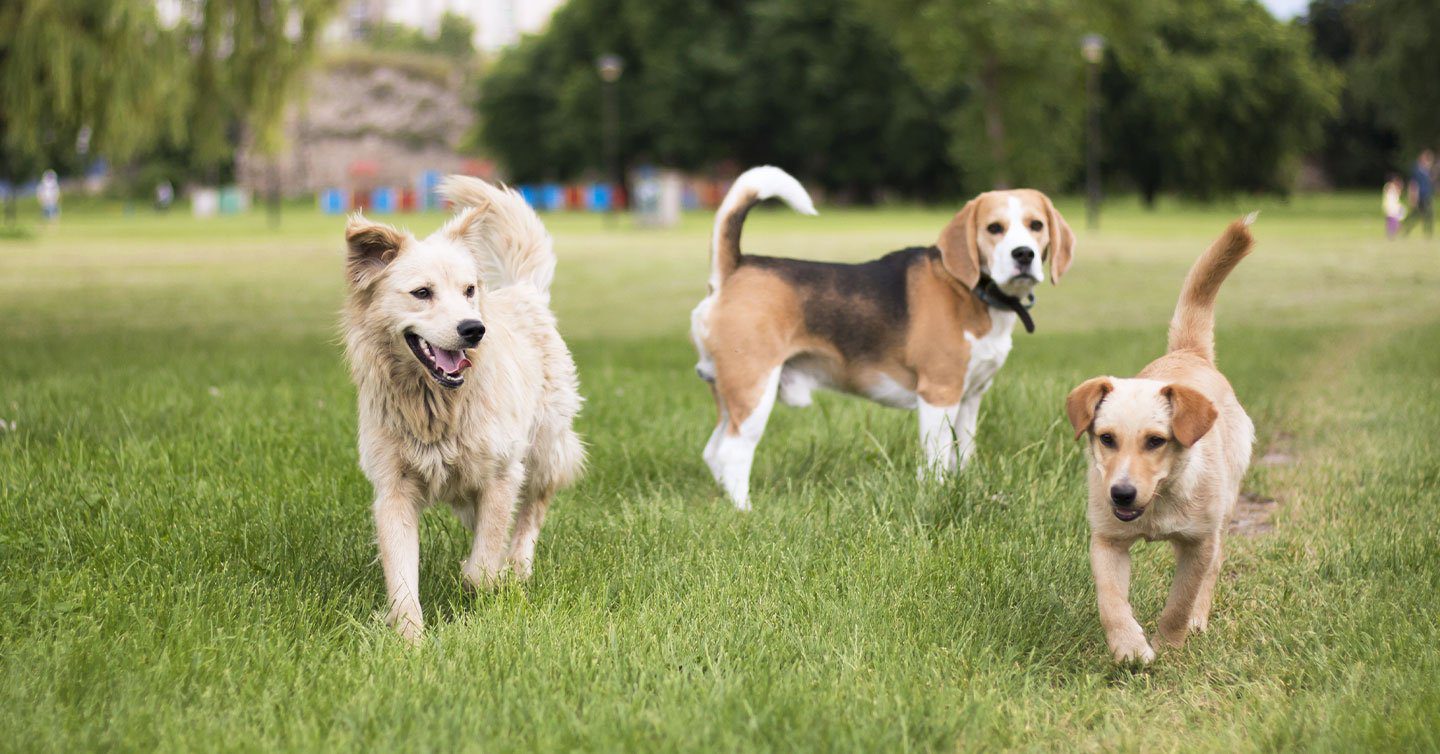Dog parks, in theory, should be a haven of dogs living their best lives with their friends. They are often a go-to for city dogs that do not have their own yard, and they can be a place for fellow dog-owners to get to know each other. However, there is more responsibility required than carefree fun at these community spaces. Believe it or not, trainers often do not recommend dog parks because of their unpredictability and chaotic environments. They can be detrimental to nervous and untrained dogs, and irresponsible owners can ruin the fun for everyone there. Sometimes, though, the dog park is a necessity when you live in an apartment or in a city, so it is key for you as a dog parent to participate responsibly and know what is best for your dog.
First and foremost in dog park etiquette is checking up on the rules and requirements to attend a specific park. Most require that your dog is registered and fully vaccinated, and some may even require fees or memberships. Do a quick search through city-run websites, the park’s social media, or local message boards before making the trip.
1. Just bring yourself and your dog.
Especially at peak hours, it is polite not to take up too much space so the dogs have enough room to run. Don’t bring along your whole squad in the gated confines of the park. If your friends or family are tagging along, they should stand on the other side of the fence. Keep the attendees down to you and your dog. A large group of people in the dog run area can make the environment feel more chaotic than it already is.
Leave the kids at home. Children, especially very small ones, can easily get toppled over by running dogs. Plus, not all dogs are good around kids, and not all kids know how to treat other dogs.
Finally, don’t bring food. Food remnants can attract vermin to the park and become quite a distraction to the dogs. Imagine every single dog in the park at your feet begging for a bite. Some dogs will become fixated and not leave you alone, and some dogs’ resource guarding may be triggered. Save the snacks for later.
2. Keep your dog in the area that is appropriate for them.
There is a reason most dog parks have designated areas for large and small dogs. These were created for the dogs’ safety. This can be beneficial for small dogs that are a bit intimidated by bigger ones, and it keeps them from accidentally being run over. Do not be tempted to bring your small dog into the large dog area because there are more dogs to play with, or vice versa. Safety is more important than the party. Another dog it’s size will show up soon.
3. Stay off your phone.
You need to have ALL of your attention on your dog. Things can go wrong in a split second, and having your eyes on your dog the whole visit is key. You need to be able to act quickly without distractions. Just like your phone when you’re driving, whatever you’re doing can wait until after the trip.
Pet Pro Tip: New to feline dental care? Join the Pumpkin Wellness Club, a new program that actually pays you for getting your cat the routine preventive care that they need to stay healthy. Members have the option to get up to $150 in cash for dental cleanings each year, plus even more savings on vaccines and annual health screenings.
4. Understand dog body language. Remove your dog immediately if there is any tension.
This is general dog ownership etiquette. First understanding your dog’s personality should determine if they would thrive or have difficulty in an environment like the dog park. Although your dog can’t talk, their body language makes it clear how they’re feeling. This is also beneficial for observing other dogs yours may be playing with. A wagging tail does not always mean a dog is happy. It can often reflect nervousness or fear. A dog rolling over to expose its belly does not always mean the dog wants to play or have belly scratches. Sometimes it means they are scared and trying to show they are submissive.
Like humans, dogs might just not like each other. There’s no way of knowing if your dog and a new frenemy will let things go, or if things will escalate after hints of apprehension. This is why leaving the dog park immediately if tensions arise is important. It is more likely that things will get worse, than better. Don’t just pull your dog to the side and wait for things to subside. Leashing up and going back home is the safest decision. Also, do not feel rude to break off a conversation to separate any squabbles. Safety is more important than whatever conversation you may be having. Know when it’s time to leave.
Situations where you should remove your dog:
- If your dog becomes fixated on another dog and will not leave them alone. The other dog’s body language will show they are uncomfortable. It will likely escalate.
- Vice versa, if your dog is being fixated on by another dog, it is also a good idea to remove your dog from the park altogether to alleviate the situation.
- If your dog seems scared, overwhelmed, overstimulated, nervous… remove your dog. He wants to go home. Do not force them to stay as it can intensify their feelings or lead to a new-found anxiety in their regular behavior.
- If your dog is the center of any fights or tension, immediately remove your dog.
Another important thing to note is that although leashes should be removed when entering, keep it close on hand to help pull away any dogs that may be in a tiff. Slip leads are also a good safety tool to carry along, as they can be put on a dog quicker than a regular clip-on leash. Avoid retractable leashes; they are not as secure as standard leashes.
5. Pick up after your dog.
You’d think this one would go without saying! Your city dog park often does not have anyone to maintain it other than volunteers. It is up to the park goers to keep it nice and clean. Always be prepared with poop bags. Don’t be ashamed to ask fellow park goers for one if you need it. If there isn’t a hose at the park, bring a big bottle of water to wash away remnants of poop and to dilute away pee (depending on what the park ground is made of). This helps the cleanliness and smell of the park, and it keeps away pests. Washing away waste also prevents the spread of illnesses and parasites. If your dog runs through feces, it can get stuck in their paw pads. The next time your dog licks their paws, they could ingest it and contract some nasty worms.
6. Do not rely on the dog park for all exercise and socialization.
Although it seems like the easiest option, relying on the dog park for exercise and socialization is actually cutting a lot of corners on your dog ownership, and on your dog’s development. It may seem convenient to just drop them off and let them run around, but the lack of structure can have some negative consequences for their training. Taking the time to take your dog on a long walk is incredibly important for exercise, focus, sniffing, and (most importantly) bonding with each other. As for socialization, it was mentioned earlier in this article that because of the chaos and overstimulation, dog parks are actually not ideal for developing your dog’s socialization skills. Socialization is more effective in one on one situations that can be controlled and monitored. Puppy socialization classes exist for this reason, and you can ask your neighbors or friends with dogs for play dates. Talk to a trainer about the best option for your dog.
7. Dog parks are not for everyone, and that’s okay!
Unfortunately, the following are indicators to avoid the dog park altogether and find alternative activities for you and your pup. While some dog parks may have rules barring dogs that fall into these categories, others may not state it explicitly. However, it likely still applies as an unspoken rule, all with your dog’s safety and enjoyment in mind. Exceptions are few and far between.
Do not take your dog to a dog park if:
- They are not fully vaccinated. Similarly, if their vaccinations are not up to date. Not only could your dog become gravely ill from catching diseases such as Parvo, but they can also spread illnesses to other dogs.
- They are under ~9 months old. In addition to making sure your puppy is completely vaccinated, a dog park can actually be adversary to your puppy’s socialization and training. The science of puppy socialization is quite particular to make sure you are raising a happy, relaxed pup. The AKC, Hills Pet, and the ASPCA actually recommend that unsocialized dogs don’t go to the dog park because of how unregulated and unpredictable the behavior of other dogs can be. One random fight can affect your dog (and puppy) forever. Opting for puppy socialization classes or one-on-one meetings with friends’ dogs is much more ideal, as they can be monitored and controlled. Waiting until they are about 9 months old gives you enough time to get a solid foundation in their training.
- She is in heat. Other dogs can sense this, creating a dangerous environment for your female pup surrounded by boy dogs literally fighting to get near her. Of course, unplanned dog pregnancies are not ideal. Just wait until the heat cycle is over in a week or two.
- They are not spayed or neutered. AsLike mentioned above, this can create an aggressive environment among intact males, and result in unwanted dog pregnancies. Plus, all the humping isn’t why you brought your dog to the park. Your time can be better well- spent than constantly having to pry dogs off of each other.
- They have resource guarding problems. Avoid bringing toys to the park, as dogs may fight to get them.
- They are dog or human reactive. Bringing your anxious dog to an environment that is full of what makes them anxious is a recipe for disaster. There are better ways to train and work on your dog’s reactivity.
- They’re pushy. If your dog is friendly but the type to nag other dogs for attention, the dog park may not actually be a good fit for them. This behavior can irritate other dogs, resulting in snapping or fights. Work on teaching your dog how to give others space before you take them.
The best outcome of going to the dog park is that your dog has a positive experience. Because the dog park is a human-made environment, it is up to us as dog parents to make the space as clean, friendly, and safe as possible for our dogs and others. Dog parks aren’t for everyone, but if it seems appropriate for your dog, your own etiquette ensures that he or she is having the best time possible. Follow the listed guidelines and unspoken rules, keep a watchful eye on your dog, and please… clean up their poop.




